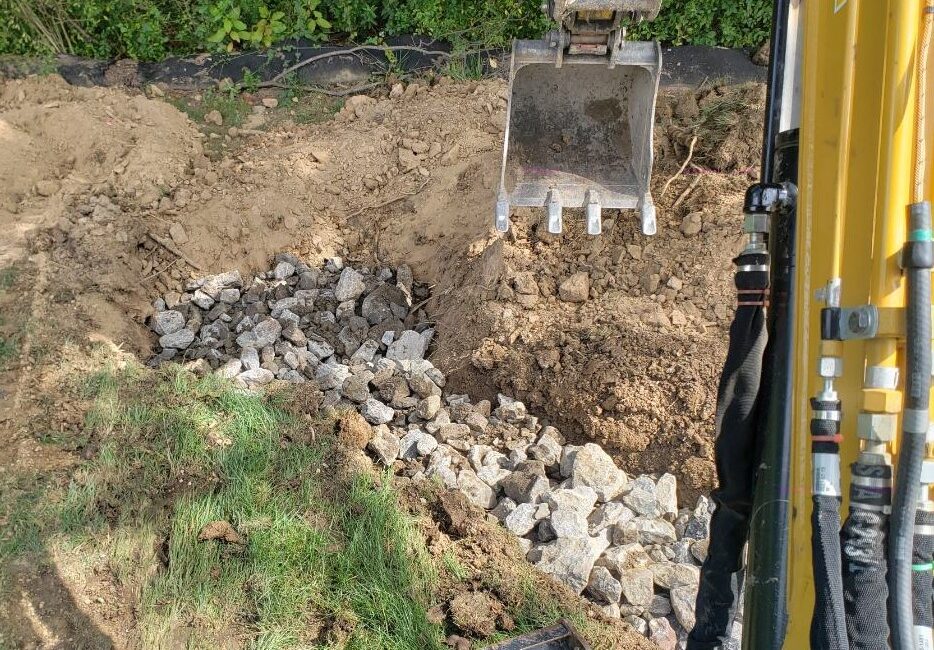Drainage Control for Beginners
If you’re someone who has never been introduced to the world of drainage control, it could definitely be overwhelming at first. There are so many different options for so many different circumstances for each unique piece of property. But don’t worry, here at MMC Land Management, our equipment operator with over 13 years of experience, Al Kaleugher, has you covered.
The overall goal of drainage control is to help reduce stormwater runoff by collecting and directing water away from your property. He says, the first thing to know before anything else, is what is causing the water to pool. Typically, this is caused by a depression in the landscape, which can be solved with a wide variety of remedies. The quickest fix is to simply fill in the depression with topsoil to make the land the same grade, but this isn’t always possible. If the water is pooling in an area where laying topsoil won’t work, you can opt to install a French drain.
Throughout his 13 years, Al has installed thousands of French drains all over Pennsylvania. What is a French drain you ask? A French drain is a trench system that uses gravity to direct water through pipes that are buried underneath layers of gravel. For a French drain to be effective on your property, there must be a high end and a low end, that way the pipe falls downhill, and the water falls downhill to the desired location. This entire trench system is covered by fabric and soil so that grass can be planted on top, but the fabric also serves to ensure that only water is making its way down to the pipes so that they do not clog, and the downspout can run into a rain conductor.
A rain conductor runs underground to a dug pit filled with gravel and allows the water to then soak into the ground. It would be ideal to fill the pit with stone to the level of the ground so that it sinks through the gravel into the ground, but most people would not want to look at a random pit of gravel in the middle of their lawn. To ensure your lawn looks normal and healthy after installation, a good rule of thumb is to have the high end be at least 8 inches underground so that stone and fabric and topsoil all have space.
There are two different types of pipes that can be used within a French drain system. Corrugated pipes are flexible, light weight, and sold in 100-foot rolls, in comparison to PVC pipe which is sturdier and more durable therefore it will not crush like the corrugated pipes. Additionally, PVC pipe usually comes in 10-foot pieces, however you will need more fittings to go around curves and bends, as well as couplers to join the pipes together. If you don’t use these, there is a chance the gravel could go in between the two pipes and cause a blockage.
Even though French drains are among the most common drainage systems, it is still crucial to be aware of all the other drainage control options that are out there. Depending on the situation, if the water proves to be an ongoing problem, a permanent solution could be to install a rain garden if there is nowhere else for the water to go. Another choice is a rain barrel, however, that usually is not a first-choice due to the fact that the barrel will overflow if the water isn’t used in time.
Al explained a common misconception he sees often within drainage control that has to do with retaining walls. A wall is not a form of drainage. When you build a wall on your property, you always put a French rain behind the wall at the bottom, while making sure to fill a foot wide from the back side of the block with stone over top of the drain. This way when the water comes down across the drain it has somewhere to go. It is a smart choice to build a retaining wall in the fall, rather than waiting until spring, not just to beat the rain, but come springtime your landscape contractor is going to be booked up.
Another potential fix could be to focus on aerating your lawn regularly. The simple act of lawn aeration helps increase the permeability of the lawn, which allows more water into the soil at a fast rate. It is important to prioritize lawn aeration on schedule, while your grass is growing aggressively.
A solution that is similar to simply filling in the depression with topsoil would be installing a swale drain. This is a half round depression or ditch where one end is high and one end is low, keeping water from going into the neighbor’s yard, or over a hill, by directing it somewhere where it is safe to run off.
There is an extensive amount of information out there on best practices when it comes to drainage control, but by implementing the right techniques and tools, you can effectively manage excess water on your property, prevent erosion, and maintain a healthy and vibrant landscape. Remember to assess your specific needs, plan accordingly, and seek out a professional when necessary.



